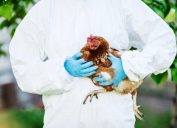Bird Flu Spreading in Cats—These Are the Symptoms
The evolving disease is now transmissible through mammals, say researchers.

Bird flu cases within mammal populations are steadily on the rise. Also known as the highly pathogenic avian influenza (HPAI) virus, this disease typically spreads through contact with sick or dead infected birds, but research now suggests that the potentially fatal virus can be transmitted between mammals, including domestic cats.
RELATED: Bird Flu Detected in Grocery Store Milk—What That Means for You.
Since March 2024, bird flu has been detected in 34 dairy cattle herds in nine different states, according to the U.S. Department of Agriculture's (USDA) Animal and Plant Health Inspection Service. And these numbers are only growing.
The uptick in mammal-to-mammal bird flu transmission has veterinary medicine experts concerned about the virus' potential to grow and spread—and what it means for house cats and, consequently, pet owners.
Researchers first caught wind of the evolving virus in felines when a colony of farm cats became gravely ill after consuming a trough of raw cow's milk.
In a new study published in the journal Emerging Infectious Diseases, experts said the cats experienced a myriad of adverse health effects while the cows, for the most part, swiftly recovered. However, the infectious cattle did produce unusually thick and creamy yellow milk during that period, which experts now believe was the catalyst.
Bird flu impacted the cats' mental and physical health. The most common symptoms included depression, stiff body movements, blindness, circling, impaired muscle coordination, and severe discharge from the eyes and nose. It was later revealed through testing that the virus had spread from the cats' lungs to their brains, hearts, and eyes. Within four days, half of the sick cats had died.
"Therefore, our findings suggest cross-species mammal-to-mammal transmission of HPAI H5N1 virus and raise new concerns regarding the potential for virus spread within mammal populations," stated the authors, who are veterinary researchers from Iowa, Texas, and Kansas.
It's important to note that the World Organization for Animal Health (WOAH) also reports that infected cats may exhibit a loss of appetite, fever, difficulty breathing, respiratory issues, and jaundice.
Bird flu only recently made the jump from avian creatures to mammals, but the rate at which it's evolving has veterinarians perturbed. Within a month's time span, the influenza virus has infiltrated dairy fields in nine different states.
As of this reporting, most cases are centralized in the Midwest in Kansas, South Dakota, Michigan, and Ohio, per the USDA's Animal and Plant Health Inspection Service. However, the cattle in Texas, New Mexico, Idaho, North Carolina, and Colorado have also tested positive for bird flu.
If you suspect that your cat has come in contact with a sick bird or consumed infected cow's milk, WOAH recommends quarantining your cat from other pets and scheduling an appointment with a veterinarian as soon as possible.





















